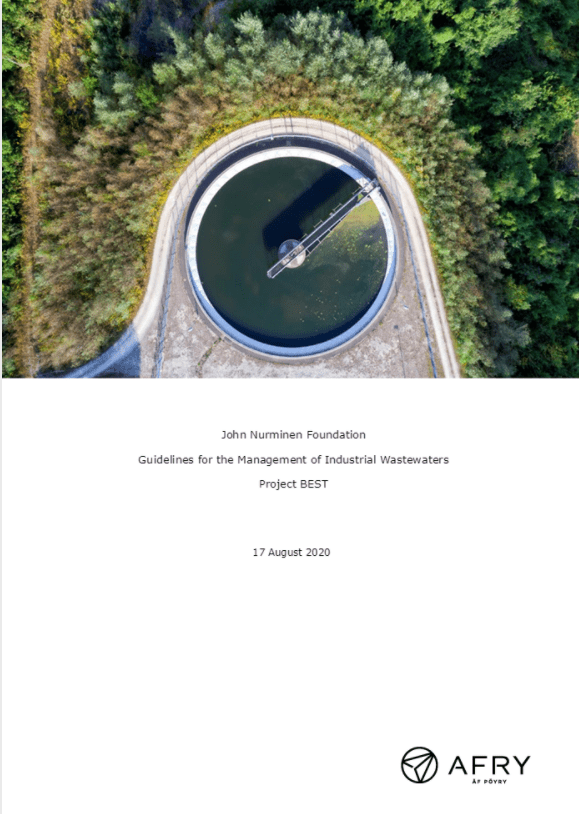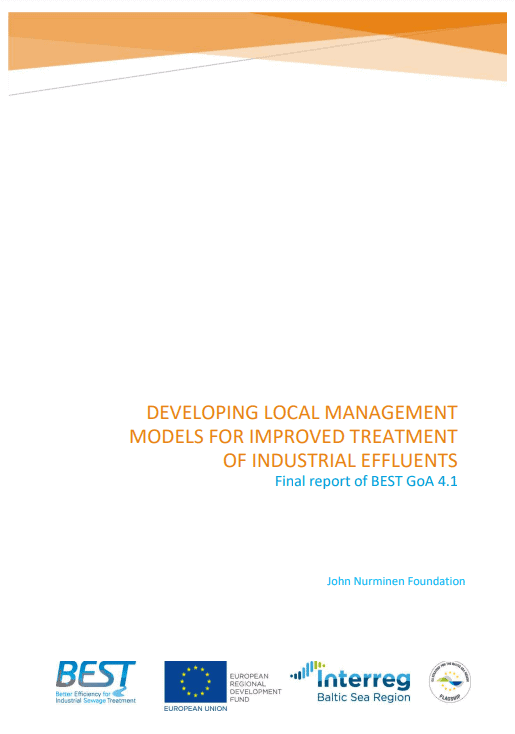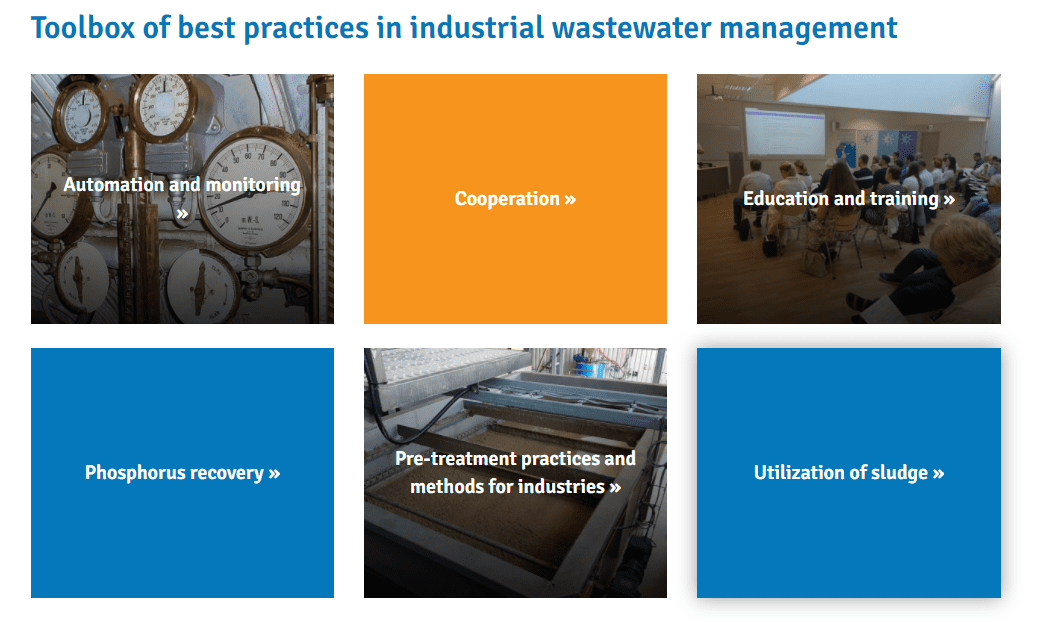BEST
Industrial wastewaters are a considerable challenge for municipal wastewater treatment plants (WWTPs) as they require special treatment and management. Industrial wastewater differs from domestic wastewater due to factors such as its high solid contents, hazardous substances, and higher and fluctuating volumes. Municipal WWTPs were originally designed to treat only domestic sewage and not water with abnormal contents, such as industrial wastewater. Therefore, industrial wastewater could seriously harm the treatment process and its efficiency if it is not handled correctly.
Such a discharge could cause capacity and safety problems at WWTPs, inhibition of the biological treatment process steps, and the pollution of wastewater sludge, which prevents recycling and further use. Even modern and efficiently functioning domestic wastewater management at municipal WWTPs may be endangered by uncontrollable industrial wastewater discharges. Ultimately, such problems can lead to higher discharges of nutrients and harmful substances into the natural environment.
BEST – Better Efficiency for Industrial Sewage worked to improve the treatment of industrial wastewaters across the Baltic Sea region and consequently reduce a load of nutrients and hazardous substances entering the Baltic Sea.
Budgets
in numbers
-
3.40MillionTotal
-
2.67MillionErdf
-
0.10MillionEni + Russia
-
0.00MillionNorway
Achievements
Assessing industrial wastewater management in the region
Currently, data and information regarding the treatment of industrial effluents entering municipal WWTPs are scattered in different countries and organisations across the Baltic Sea region. There is not any comprehensive and comparative analysis of the available data.
Thus, the BEST project has created an overview of the situation in the Baltic Sea region on the EU level and national legislation regulating indirect wastewater discharges from industries, identifying the main polluting sectors in each country, and their possible impacts on the treatment processes at the municipal WWTPs.
The partners collected information about national legislation by interviewing experts in countries across the Baltic Sea. Furthermore, in Estonia, Latvia, Lithuania, Poland and Russia, project partners identified 2 to 3 industrial sectors of specific concern and interviewed both individual companies and associations in these industrial sectors (the food, dairy, brewery, mining, petroleum, chemicals, surface treatment and waste handling).
These interviews gave information about the regulation of industrial wastewater and cooperation between the industrial facility and the municipal wastewater treatment plant receiving the effluents.
Joining forces for better treatment of industrial effluents
Good cooperation ensures the timely exchange of information and quick response to malfunction situations. The BEST project demonstrated how regular communication results in better process control and co-treatment of industrial effluents and reduces the loading of nutrients and hazardous substances to the Baltic Sea.
Project partners developed local cooperation models to improve the management of wastewater and collaboration between WWTP, industries, and supervising authorities. They arranged local planning meetings, joint learning, and information exchange sessions as well as on-site visits. International capacity development events were used as a platform to plan, report, evaluate and develop these local practices.
Examples of successful cooperation models
For instance, project partners in Adaži municipality (Latvia) created cooperation models between the local wastewater treatment plant and its industrial customers representing mainly the food industry. The result was the development of a communication model and WWTP process management scheme, including a risk assessment procedure.
In Poland, project partners carried out an analysis of industries conveying wastewater to the Municipal Water and Sewerage Company (MPWiK) WWTPs by combining various data sources. The on-site inspections and wastewater sampling by MPWiK worked well as a preventive measure. However, the actual stream of industrial liquid waste transported to septage receiving stations with vacuum trucks caused concerns. MPWiK was advised to provide more information on the procedure of connecting industrial wastewater suppliers and make industrial wastewater suppliers more aware of their duties associated with discharging this type of wastewater to the MPWiK sewage system.
Outputs
Assessment report: management of industrial wastewaters in the region

Guidelines for the management of industrial wastewaters and the Policy Brief

Report on local cooperation models

Toolbox of best practices in industrial wastewater management

Technologies to improve treatment of industrial wastewater
Project Stories
Partners
City of Helsinki Environment Services
- TownHelsinki
- RegionHelsinki-Uusimaa
- CountryFinland
- RepresentativeLotta Ruokanen
- Phone
- E-Mail
- Web
Riga Technical University
- TownRiga
- RegionRīga
- CountryLatvia
- RepresentativeSandis Dejus
- Phone
- E-Mail
- Web
Tallinn University of Technology
- TownTallinn
- RegionPõhja-Eesti
- CountryEstonia
- RepresentativeKarin Pachel
- Phone
- E-Mail
- Web
Estonian Waterworks Association
- TownTallinn
- RegionPõhja-Eesti
- CountryEstonia
- RepresentativeVahur Tarkmees
- Phone
- E-Mail
- Web
Municipal water supply and sewerage company with limited liability (Leszno)
- TownLeszno
- RegionLeszczyński
- CountryPoland
- RepresentativeBartosz Zamelski
- Phone
- E-Mail
- Web
Doruchow Municipality
- TownDoruchów
- RegionOstrołęcki
- CountryPoland
- RepresentativeWaldemar Rybczak
- Phone
- E-Mail
- Web
John Nurminen Foundation
- TownHelsinki
- RegionHelsinki-Uusimaa
- CountryFinland
- RepresentativeMiina Mäki
- Phone
- E-Mail
- Web
State Autonomous Institution of Kaliningrad region "Environmental Center "ECAT-Kaliningrad"
- TownKaliningrad
- RegionKaliningrad Oblast
- Country
- RepresentativeOlga Sheshukova
- Phone
- E-Mail
- Web
Helsinki Region Environmental Services Authorithy HSY
- TownHelsinki
- RegionHelsinki-Uusimaa
- CountryFinland
- RepresentativeTommi Fred
- Phone
- E-Mail
- Web
Põltsamaa Varahalduse limited company
- TownPõltsamaa
- RegionKesk-Eesti
- CountryEstonia
- RepresentativeKuldar Kipper
- Phone
- E-Mail
- Web
Limited company E-Piim Tootmine
- TownJärva-Jaani
- RegionKesk-Eesti
- CountryEstonia
- RepresentativeKuldar Kipper
- Phone
- E-Mail
- Web
City of Warsaw
- TownWarsaw
- RegionMiasto Warszawa
- CountryPoland
- RepresentativePaweł Królak
- Phone
- E-Mail
- Web
Regional Environmental Centre for Central and Eastern Europe, Country Office Poland
- TownWarsaw
- RegionMiasto Warszawa
- CountryPoland
- RepresentativeMichał Brennek
- Phone
- E-Mail
- Web
LATVIJAS PIENS LTD
- TownJelgava
- RegionZemgale
- CountryLatvia
- RepresentativeDainis Kanepons
- Phone
- E-Mail
- Web
Gdansk Water Foundation
- TownGdańsk
- RegionGdański
- CountryPoland
- RepresentativeAlicja Loch-Dzido
- Phone
- E-Mail
- Web
-
Project managerKajsa RosqvistCity of Helsinki Environment Services
-
Legal representativeEsa NikunenCity of Helsinki Environment Services
-
Financial managerAnnaliina SkyttäCity of Helsinki Environment Services
-
Communication managerMiitta RantakariCity of Helsinki



